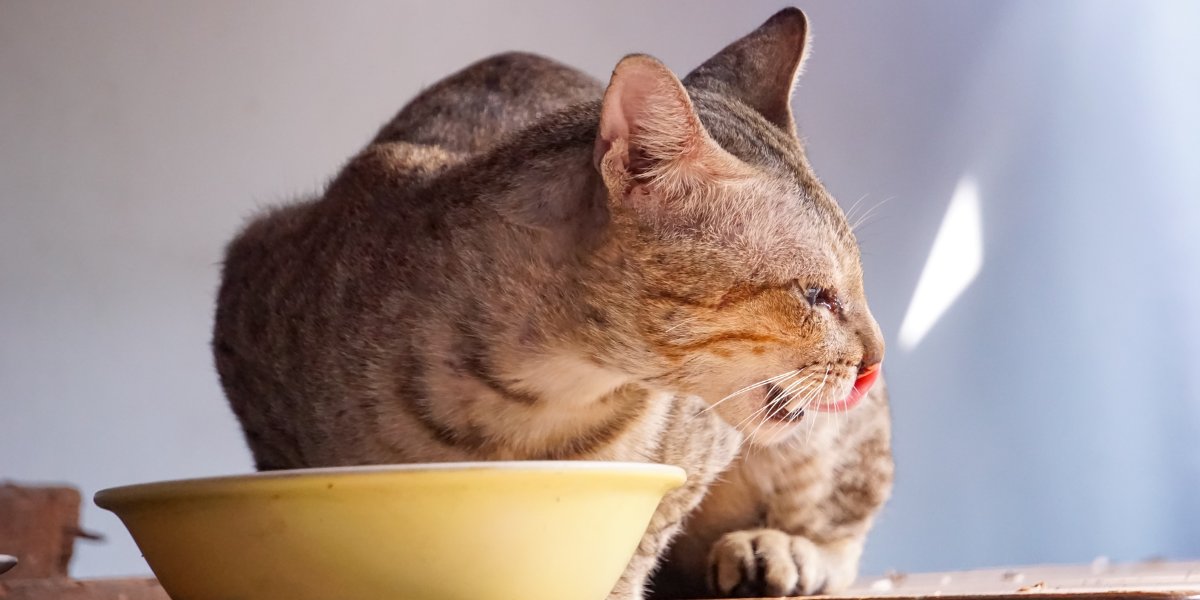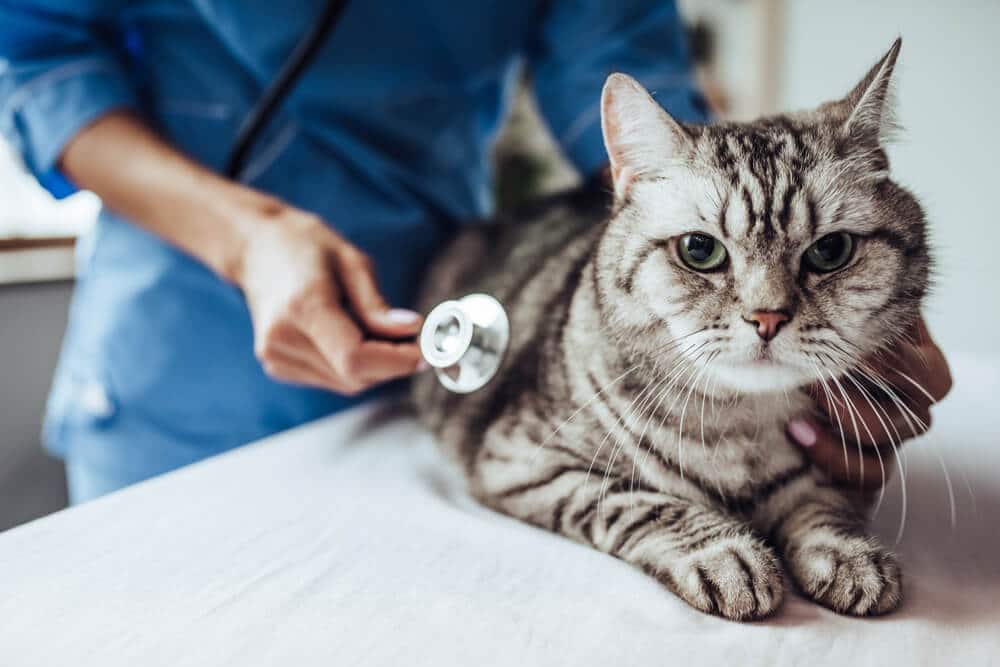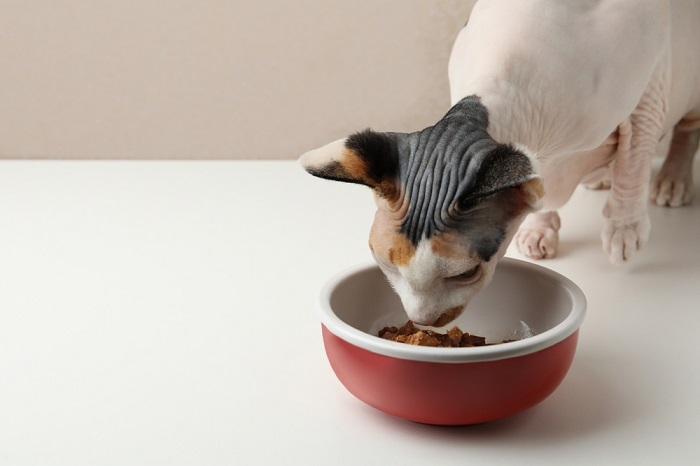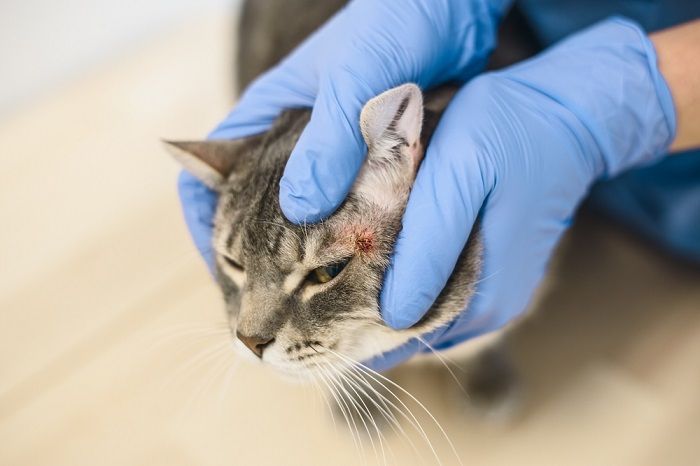
This article aims to explain the details of cat food allergies and provide a simple, clear explanation of this common type of allergic disease for pet owners.
What Are Food Allergies?
Food allergies in pets are allergic reactions to proteins in the food, with inflammation of various body parts following an allergic reaction to those proteins (allergens). Food allergies (also known as food sensitivity) are seen in dogs and cats, with dog food and cat food equally prone to provoking an allergic reaction.
How Common Are Food Allergies?
Cat food allergies are a common problem, causing 12 – 21% of cases of cats with itchy skin. They are also a common cause of inflammatory bowel disease in cats, causing signs of gastrointestinal disturbance, such as vomiting and diarrhea.
How Do Cats Get Food Allergies?
Affected cats may have a genetic predisposition to develop this allergy-based condition. Still, in most cases, there are no known specific causes, and food allergies are not more common in some breeds than others.
Symptoms of Food Allergies in Cats
Clinical signs associated with food allergies include:
1. Skin Inflammation
- Pruritus (itchiness, scratching all over, licking the feet, etc.)
- Otitis externa (ear infections)
- Recurrent skin lesions and skin infections (pyoderma)
- Alopecia (baldness)
- Miliary dermatitis (roughened patches of scabby skin)
- Eosinophilic granuloma (raised areas of pink, sore-looking skin also known as eosinophilic plaques)
2. Inflammation Of The Digestive Tract
- Vomiting
- Diarrhea
- Weight Loss
- Reduced Appetite
- Flatulence
- Abdominal Pain
- Constipation
Causes of Food Allergies in Cats
This is an immune-mediated disease (a disease of the immune system), with affected cats having a genetic predisposition to developing food intolerance or hypersensitivity to allergens in their food.
Any food ingredient can provoke an allergy. The most common food allergens are beef (18%), fish (17%), chicken (5%), with wheat, corn, dairy products and lamb (less than 4% each).
Other less commonly reported culprits include eggs, pork, rabbit, whale meat, and barley. Carbohydrates are less likely to provoke allergies than proteins. Cats can have an allergy to more than one food ingredient at a time.
Diagnosis of Food Allergies
If your DVM veterinarian suspects that your cat may have food allergies because of skin problems or digestive upsets, the following steps may be taken.
Detailed History Taking

A cat coughing doesn’t always necessitate a trip to the vet, but in some cases, a vet visit may be essential. Your vet can help you to identify and resolve the underlying cause of your cat’s cough.
Your vet will discuss every aspect of your cat’s health and lifestyle. A general history is important (e.g. sneezing, coughing, other signs of illness) to gain a full picture of the cat’s health. There are other causes of the same types of signs as food allergies, and this history will help to differentiate the various possible causes.
Itchiness caused by food allergy tends to happen all year round, while other types of allergic skin disease (eg atopy, or environmental allergies) may be seasonal (eg related to pollens). A good dietary history is essential, with close scrutiny of the cat’s diet, including details of all current and previous pet foods, the precise type of food, snacks, treats, medications, and toys.
If the food allergy is causing gastrointestinal signs, the same principles apply: a thorough dietary history is essential.
Physical Examination
Your veterinarian will check your cat over carefully.
If itchy skin is the manifestation of the food allergy, particular attention will be paid to examining the skin, noting the precise nature and pattern of the lesions in the skin, including itchy areas and areas of hair loss.
Reddened areas (erythema), nettle-sting-like rashes (papules and wheals) and excoriations (areas of self-damage by scratching) may be seen. Affected areas may include the armpits (axillae), groin (inguinal area), under the tail (perianal), around the eyes (periocular), around the mouth (perioral) as well as the ears and head.
If gastrointestinal disease is the issue, then a thorough all over examination is important.
Skin Tests
If the food allergy is manifesting as itchy skin, your veterinarian may suggest a number of skin tests to investigate the problem. Some primary veterinarians my prefer to refer you to a vet with a particular interest in dermatology (a veterinary dermatologist) for some or all of this work up to be done. Thorough parasite treatments (e.g. implementing thorough flea control) are often needed to completely rule out skin parasites.
Fungal Culture
Ringworm (dermatophytosis) may need to be ruled out by culturing skin and fur samples.
Skin Scrapings and Cytology
Itchiness is commonly caused by parasites such as flea allergy, lice, demodex, notoedres and others, so these need to be ruled out. Bacterial infections/ yeast infections need to be identified, too, in case they aggravate an underlying allergy.
Skin Biopsy
A skin biopsy does not reveal specific changes that allow the direct diagnosis of feline food allergies, but histopathology of a sample of skin does allow the ruling out of other differential diagnoses.
Gastrointestinal Tract Tests
If the food allergy is manifesting as suspected inflammatory bowel disease (IBD), further tests may include ultrasound, blood tests, and ultimately, a biopsy of the stomach or intestinal wall to confirm the diagnosis.
Therapeutic Trial With Special Diet
A food trial or Elimination Diet Trial (EDT), offering only a special limited antigen diet with a restricted protein source for 6 – 12 weeks is the only definitive way to rule in or out food allergy.
The cat must have access to nothing else other than the special hypoallergenic diet for this duration. If the cat improves during the elimination trial, then the diagnosis is confirmed, while if the cat continues to show signs of inflammation (either skin or digestive tract) then the diagnosis is ruled out.
Sometimes at the end of the trial period, a dietary challenge may be tried, deliberately stopping the exclusions and feeding the suspected offending allergen to see if there is a reaction. Often, however, this is not done because understandably, pet owners do not want their cat to develop signs again.
Treatment for Food Allergies
There are a number of treatment options.
The cornerstone of treatment is feeding only a restricted diet that does not contain any of the allergens which provoke a reaction. This may be the limited ingredient diet that was used for the food trial, or it could be a different diet.
There are various commercially produced diets that are generally recommended, or it is also possible to home-prepare a restricted protein diet.
Two types of restricted allergen diet are available:
- Novel protein diets, which are limited antigen diets where the particular protein has not been eaten previously by the cat. Examples include venison, rabbit, specific fish, and others. These diets may be commercially prepared or home-cooked (eg made using human food ingredients). The best commercial diets are prescription diets (made by companies like Purina and Hills) generally obtained via your veterinarian, as over-the-counter pet shop sourced products are more likely to include common allergens or other extra ingredients that may provoke an allergy.
- Hydrolyzed protein diets are limited antigen diets where the protein has been hydrolyzed (pre-digested) into smaller fragments of protein (peptides) which are very unlikely to provoke an allergic reaction.
Anti-allergic medication such as corticosteroids or glucocorticoids (e.g. oral prednisolone) may be used as an additional way of damping down the allergic signs. Long-acting depot glucocorticoid injections are a useful alternative for cats that are difficult to medicate.
Essential fatty acid (EFA) supplements may help in the long term by optimising skin health and so reducing the dose needed of stronger medication like corticosteroids.
Calcineurin inhibitors such as cyclosporine (“Atopica”)and tacrolimus are immune system modulators that may be useful as part of long-term treatment.
Other more recently developed anti-inflammatory medication like Oclacitinib (“Apoquel”) may not yet be licensed for cats, but may be recommended by veterinarians for certain cases.
Shampoos and baths may help some cases (e.g. specific medicated baths if malassezia infection is aggravating itchiness).
Digestive tract medication may be used to help with signs of vomiting or diarrhea.
How Much Does It Cost To Treat a Cat With Food Allergies?

The Avg. cost to treat a cat with food allergies is 50 to $150 per month for ongoing care per cat.
The cost depends on many factors of individual cases. You should ask your veterinarian for a detailed estimate before agreeing to proceed with treatment. Typically it may cost $400 to $1000 to carry out an initial workup, then $50 to $150 per month for ongoing care, including a special diet as well as anti-allergic medication.
Monitoring and Prognosis

Any food ingredient can provoke an allergy. The most common food allergens are beef (18%), fish (17%), chicken (5%), with wheat and corn.
Since the main sign of food allergies is itchiness or gastrointestinal upset, it is generally simple for owners to monitor this disease, although regular veterinary checkups are helpful. Most cases respond well to treatment with a restricted diet.
Conclusion
Food allergies commonly cause allergic skin disease and gastrointestinal disease, causing itchiness and skin rashes or gastrointestinal disturbance in cats. They often need lifelong management with a long-term special diet and sometimes ongoing medication under veterinary supervision.
Also Read: Elimination Diets For Cats: What You Need To Know?







